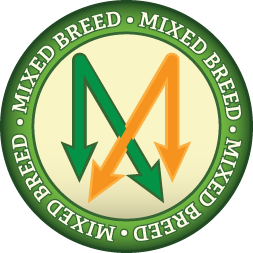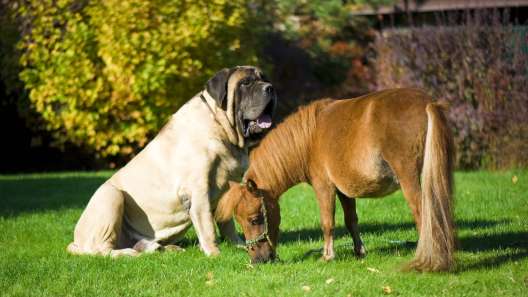
-
Activity Level:
moderate
-
Shedding Level:
moderate
-
Grooming Level:
moderate
-
Trainability:
high
-
Good for Novice Owners:
high
-
Adaptability:
moderate
-
Kid/Pet Friendly:
often
-
Prey Drive:
low
-
Watchdog:
chill
- Average Size: Giant
- Average Lifespan: 8-10 years
Saint Bernard Mix Dog Breed Information
Overview
Temperament
Adaptability
Health
Owner Experience
Grooming
Activity Level
Size
Life Span
A Saint Bernard Mix is a cross between a Saint Bernard and another dog breed. Since a mix can take on any combination of traits from their parents, it’s important to ask the breeder about the other parent breed.
If a Saint Bernard Mix takes after their Saint Bernard parent, they grow into a large, friendly, and gentle dog that loves nothing more than being around their favorite humans.
Saint Bernards are known for being gentle giants. They tend to be friendly, playful, and affectionate and get along well with children, other dogs, and other pets. As long as they have been well-socialized, they are also open and friendly to meeting strangers.
If the other parent breed is similar, then you can expect a similar temperament from a Saint Bernard Mix. You do still want to talk to the breeder to make sure you are aware of any potential quirks the other parent breed could introduce.
You can also meet the mother in person to see what her temperament is like and the type of behavior she is modeling for her puppies. The breeder should have started some socialization and training, but it is up to you to continue those things once you bring a puppy home.
A Saint Bernard is a moderately adaptable dog. They tend to be better suited for larger homes that have enough space for them. They can adapt to apartment living, but their size is an obstacle in smaller spaces.
They are a cold-weather breed that can do well in a variety of climates, but not necessarily tropical or hot climates. They also do not like to spend a lot of time alone. If the other parent breed does not introduce any traits that could affect adaptability, then you can expect a Saint Bernard Mix to be moderately adaptable as well.
Mixed-breed dogs can sometimes be healthier than purebred dogs, but it’s not a guarantee, and good breeding practices matter. Reputable breeders will screen their dogs to avoid passing preventable issues to puppies, so make sure you are asking about the health of the parents.
From the Saint Bernard side, potential health concerns to be aware of in a Saint Bernard Mix include eye disease, elbow dysplasia, and hip dysplasia. As a large dog breed, they are also at a higher risk of bloat. Knowing how to reduce the risk of bloat in dogs and what symptoms to look for can make sure you are able to get help if you need it.
Although they grow into a giant dog, the Saint Bernard is a good fit for owners of all experience levels. They are intelligent and eager to please. Because of their size, it’s important to work on leash training and to train your dog not to jump up early.
If the other parent breed is also easy to train and a good fit for novice owners, then you can expect the same from a Saint Bernard Mix. If the other parent breed is more difficult to train, you’ll want to be prepared to enroll in puppy training classes. There are several benefits of puppy training classes outside of training, so they tend to be a good idea regardless.
A Saint Bernard Mix can inherit a coat similar to one of their parents or a coat that is a combination of both of them. The Saint Bernard coat has two varieties – long and short. No matter which coat type, the care is the same.
If a Saint Bernard Mix inherits the Saint Bernard coat, they will shed moderately year-round with heavier seasonal shedding. Weekly brushing and the occasional bath are the minimum; daily brushing is recommended during seasonal shedding events. It’s also not a bad idea to have an undercoat rake in your mix of dog grooming brushes.
In addition to coat care, you will also need to take care of your Saint Bernard Mix’s nails, ears, and teeth. Nail trims once or twice a month keep them from growing too long. Ear checks weekly with careful ear cleanings as needed can help prevent ear infections. Daily dental care with dog-friendly toothpaste helps prevent dental diseases later in life.
The Saint Bernard may be a large working dog, but they are not high-energy. They sit in a more moderate range. Daily walks plus some playtime are usually enough to keep them happy. Because they are happy to spend time with you, they will likely be up for more activity if you are.
If the other parent breed also sits in a moderate range, then you can expect the same from a Saint Bernard Mix. If they are lower or higher energy, then you will need to be prepared for a mix to be somewhere in that potential range.
Fully-grown Saint Bernards usually stand 26-30 inches tall at the shoulder and weigh 120-180 pounds. The other parent breed can have a big effect on this, especially if they are the mother. It’s not a guarantee, but you can meet the mother in person to get an idea of what size to expect in a fully-grown Saint Bernard Mix.
A Saint Bernard generally lives for 8-10 years on average. Although the other parent breed may affect this slightly, you should be able to expect a similar average life span from a Saint Bernard Mix.









